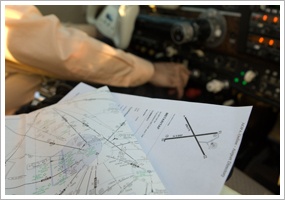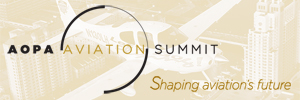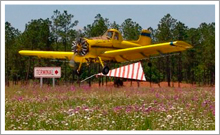| ||||
| | FT News | Inside AOPA | TRAINING PRODUCTS | FINAL EXAM | |||
TRAINING TIPsDivision, not distraction
It takes self-discipline to stay properly focused when duties pile up. Lavishing too much attention in the wrong place could put you across the line from division of attention to distraction. For example, searching for opposing traffic reported nearby is always important, but don’t let your altitude or heading stray. Realizing that you have begun to drift upward from an assigned altitude, don’t let avoiding the deviation cause you to miss a call from ATC. Those are examples of fixation, the subject of the Nov. 19, 2004, “Training Tip.”
Something going wrong after takeoff is a common distracter, requiring keen focus. See how Thomas B. Haines made some rapid-fire decisions in his August 2006 AOPA Pilot “Waypoints” column. Even a seemingly routine operation like taxiing can be a distraction hotbed. Be forewarned by Dave Wilkerson’s discussion in “ Checkride: Getting around on the ground.”
You may know from the practical test standards that distractions are an important area for scrutiny, and your designated pilot examiner may create a “realistic distraction” during the checkride. It could be as simple as his opening a casual conversation while you are performing a delicate maneuver. “NASA's Aviation Safety Reporting System reports that cockpit conversation is far more distracting than the industry once believed. The more personal the conversation, the more distracting. Beware. The PTS directs examiners to provide realistic distraction during the flight. Many examiners launch an innocuous conversation during slow flight specifically to test your handling of distractions,” Wilkerson wrote in this article on AOPA Flight Training Online.
What to do? The examiner won’t mind if you politely defer chatting until a better time—preferably when you’re back on the ground after successfully completing the checkride. YOUR PARTNER IN TRAININGWinter made a very early arrival to some parts of the country last week when a nor’easter dumped rain and snow all over the East Coast. Don’t forget that if you find yourself grounded by the weather, your schedule, or other intrusions, you can keep your head in the game by reading every aviation article you can find, or using a desktop simulator to practice basic and instrument flying skills. Research and plan trips to future destinations with AOPA Online’s flight-planning resources—the AOPA Internet Flight Planner and AOPA’s Airport Directory Online. Also, be sure to visit the AOPA Air Safety Foundation home page for free interactive courses, Safety Advisors, quizzes, and a schedule of safety seminars in your area.
Did you know that student pilots who join AOPA are three times more likely to complete their flight training? Membership includes unlimited access to aviation information by phone (800/USA-AOPA, weekdays from 8:30 a.m. to 6 p.m. Eastern time) or from AOPA Flight Training Online or AOPA Online. If you’re not already a member, join today and get the pilot’s edge. Login information is available online. FLIGHT TRAINING NEWSFlight school association formsFilling what it calls the last void in aviation representation, a group of Pennsylvania pilots and flight school owners has launched the Flight School Association of North America. According to principal Bob Rockmaker, the project has received very positive attention so far. The group plans to host a national conference next year and also to start an accreditation program. Rockmaker said he thinks there are 1,700 to 1,800 viable flight schools in the country, and the group is aiming to gain 10 to 20 percent of them for membership. Membership fees range from $150 to $750 depending on when the flight school joins and how many aircraft it operates. Individual memberships are also available. Rate your simulator training experienceAlready earned your sport, recreational, or private pilot certificate? If so, did you use Microsoft Flight Simulator during your flight training? The AOPA Air Safety Foundation is gathering information about pilots' use of Flight Simulator in primary training. Take this survey to let the foundation know how you have used the software package and how effectively it has helped you hone your skills for flight. ATP adds locationsNational flight training provider Airline Transport Professionals (ATP) is adding two new locations: one in New York and the other in Los Angeles, the company announced. Camarillo Airport, north of Los Angeles, will be the company’s fourth training location in Southern California. Classes are expected to start there next month. ATP is opening its first location in the New York area at Westchester County Airport in White Plains. That location is expected to open early next year with classes to begin in March. Both locations will offer the complete flight training curriculum from private pilot through airline transport pilot in Piper Seminoles, Diamond DA40s, and Cessna 172s. When ATP begins taking delivery of the Diamond D-Jet, both locations are also expected to offer that training. Danger zone: Tackle carb iceWhether you're taking off for a flight over the brilliant fall foliage or just starting to feel relief from the summer heat, chances are you're operating in the "danger zone" for carburetor ice. Carb ice can form over a wide range of outside air temperature and relative humidity, and icing is most likely to occur when temperatures fall between 50 and 70 degrees Fahrenheit and the relative humidity is greater than 60 percent. Learn more about the year-round possibility of carb icing in the AOPA Air Safety Foundation's new Safety Brief, Combating Carb Ice . The safety brief will help you recognize the symptoms of carb ice, respond properly to its occurrence, and develop a preventive plan to avoid carb ice encounters. Aviator flight school becomes Aviator CollegeWhat began as Ari Ben Aviator Flight School in 1982 is now Aviator College of Aeronautical Science and Technology in Fort Pierce, Fla. Aviator College will offer an associate degree in aeronautical science beginning in January. All aviation coursework will take place at the St. Lucie County International Airport facility, while general education requirements will be completed through nearby Indian River State College. According to Aviator, the program is accredited by the Accrediting Commission of Career Schools and Colleges. Courses include private pilot through commercial pilot certificate with multiengine rating and CFI, as well as classroom work in pilot career planning and other related subjects. The school will also offer regional jet training with its Level 5 CRJ flight training device. Aviator will host an open house for potential applicants from 10 a.m. to 4 p.m. on Friday, Oct. 23, and Saturday, Oct. 24. Inside AOPAAviation Education Expo attracts more than 250 studentsMore than 250 high school students from Maryland, Virginia, and the District of Columbia attended a job fair held last week at ProJet Aviation at the Winchester Regional Airport in Virginia. The Aviation Education Expo brings together local and national exhibitors and speakers to educate young people on the value of aviation as a career. AOPA Flight Training Associate Editor Ian J. Twombly discussed the breadth of careers available in aviation and what the future looks like for the career path. AOPA Aviation Technical Specialists Andy Sable and Chris Moser handed out free flight training materials and guided students through landings in an Extra 300 using a flight simulator. "The students really enjoyed performing turns, climbs, descents, and—specifically—aerobatics!" Sable said. Help GA without giving a centYou can help fund the GA Serves America campaign efforts to protect our freedom to fly without giving a cent by contributing points from your AOPA credit card with WorldPoints rewards. Donating your points is easy. Just log in to your AOPA WorldPoints credit card account online, select “Cash,” then “Get Started,” and “Add Account” in the “Donate my Points to GA Serves America” tool bar. Provide an account nickname and your e-mail address, then confirm and save the account. Click on “Redeem Now” to donate your points to GA Serves America and enter the amount of points you would like to donate. It’s a step that can make a world of difference in the fight for GA rights. Don’t have the AOPA WorldPoints Rewards Credit Card? Apply today.
TRAINING PRODUCTSPink headsets from Powder Puff PilotPowder Puff Pilot, an online retailer of pilot products designed for women, has added pink aviation headsets to its selection. Company owner Sue Hughes, a CFI, says the headsets are part of a line of products designed to attract women to aviation by making them feel more comfortable in the cockpit. The headsets, which are bubble-gum pink and bear the company logo on the non-mic earcup, come in both active ($299) and passive ($179) noise reduction models. Order online.
Note: Products listed have not been evaluated by ePilot editors unless otherwise noted. AOPA assumes no responsibility for products or services listed or for claims or actions by manufacturers or vendors. FINAL EXAMQuestion: I have heard that the FAA is extending the duration of student pilot certificates to five years. Is this true?
Answer: That is partially correct. The FAA recently extended the duration of third class medical certificates to five years for those applicants who were under the age of 40 on the date of issue. This caused those pilots to have a valid medical certificate, but an expired student pilot certificate. In order to eliminate this issue, the FAA has extended the duration of student pilot certificates to match the duration of the third class medical certificate. If you were under 40 years of age on the date your medical certificate was issued, your student pilot certificate is valid for five years, just like your medical. If you were 40 or more years old on the date of your medical exam, your student pilot certificate is valid for two years, just like your medical. Got a question for our technical services staff? E-mail [email protected] or call the Pilot Information Center, 800/872-2672. Don’t forget the online archive of "Final Exam" questions and answers, searchable by keyword or topic. Picture Perfect
AVIATION EVENTS & WEATHER To submit an event or to search all events in the calendar, visit AOPA Online. For airport details, including FBO fuel prices, see AOPA’s Airport Directory Online. Flight Instructor Refresher ClinicsThe next AOPA Air Safety Foundation Flight Instructor Refresher Clinics are scheduled in San Diego, Calif., Atlanta, Ga., and Austin, Texas, Nov. 14 and 15; Anchorage, Alaska, Albuquerque, N.M., and Reston, Va., Nov. 21 and 22; Denver, Colo., and Orlando, Fla., Dec. 5 and 6; Northbrook, Ill., Dec. 12 and 13; San Jose, Calif., Baltimore, Md., and Detroit, Mich., Jan. 9 and 10. For a complete schedule, see AOPA Online.
Can’t make it in person? Sign up for the CFI Refresher Online. AOPA Air Safety Foundation Safety SeminarsAOPA Air Safety Foundation Safety Seminars are scheduled in Palmdale, Calif., Oct. 26; San Luis Obispo, Calif., and Lynchburg, Va., Oct. 27; Fresno, Calif., Oct. 28; Concord, Calif., Oct. 29; Tampa, Fla., Nov. 5 and 6; Tampa, Fla., and Pikeville, N.C., Nov. 7; Jamestown, N.C., and Greenville, S.C., Nov. 9; Decatur, Ga., and Smithfield, N.C., Nov. 10; Huntsville, Ala., and Castle Hayne, N.C., Nov. 11; Burbank, Calif., and White Plains, N.Y., Nov. 16; Ontario, Calif., Nov. 17; Costa Mesa, Calif., Nov. 18; San Diego, Calif., Nov. 19; Marietta, Ga., Dec. 1; Birmingham, Ala., Dec. 2; Pensacola, Fla., Dec. 3; West Palm Beach, Fla., Dec. 7; Tampa, Fla., Dec. 8; Towson, Md., Dec. 9. Topics vary—for details and a complete schedule, see AOPA Online. | Got news? Contact ePilot. Having difficulty using this service? Visit the ePilot Frequently Asked Questions now at AOPA Online or write to [email protected]. |
| Member Tools : Send feedback | Update member profile | Change email address | Unsubscribe | ePilot Archive Editorial Team : ePilot Flight Training Editor : Jill Tallman | ePilot Editor: Sarah Brown | Contributor: Alton Marsh |

 When a student pilot reaches the point of workload saturation during a flight lesson, among the lessons learned is one about “division of attention.” Dividing attention between competing demands gets easier with practice, and when you master workload-reducing methods such as
When a student pilot reaches the point of workload saturation during a flight lesson, among the lessons learned is one about “division of attention.” Dividing attention between competing demands gets easier with practice, and when you master workload-reducing methods such as 



